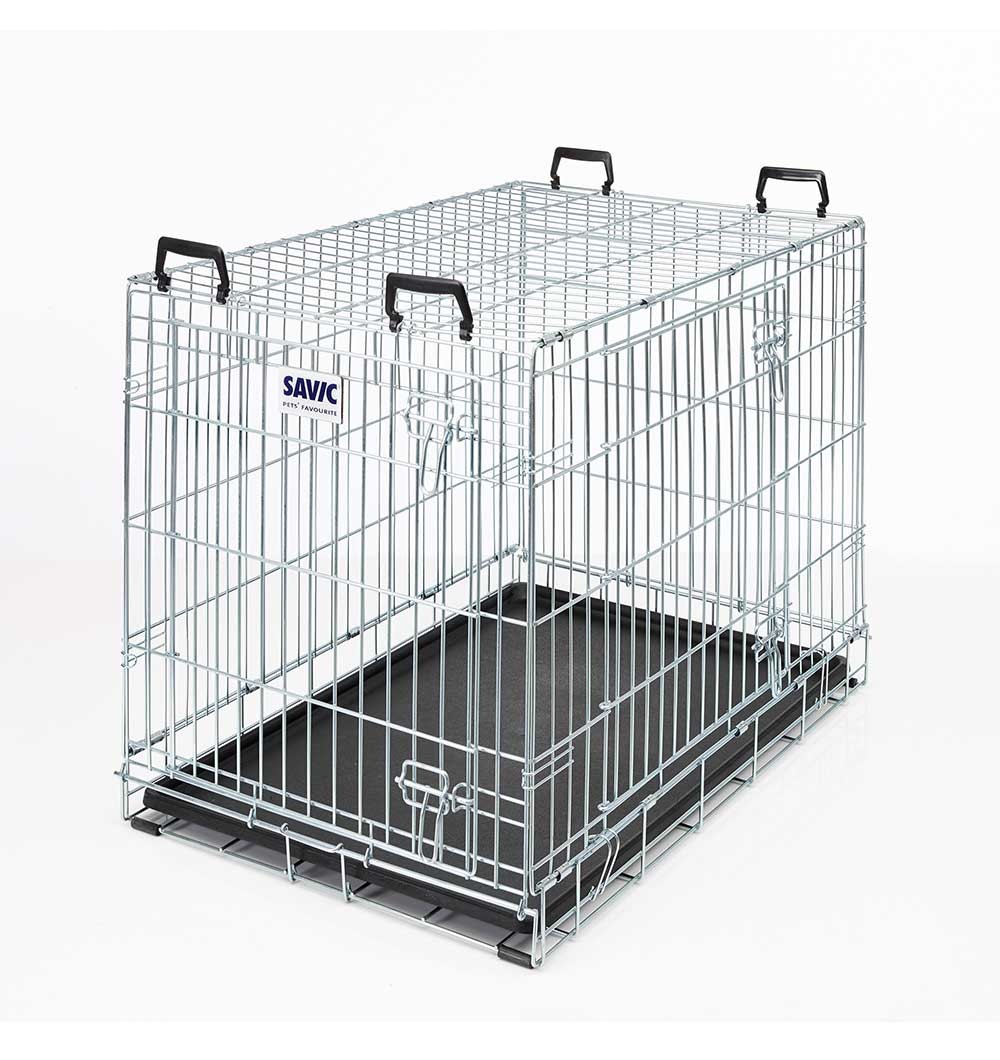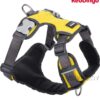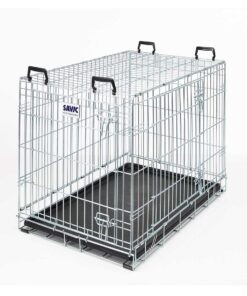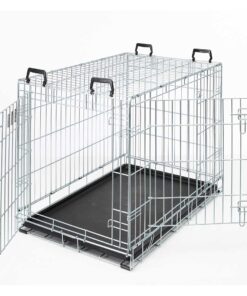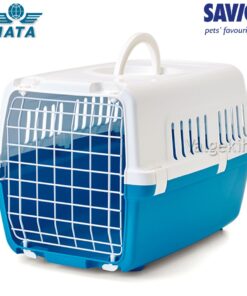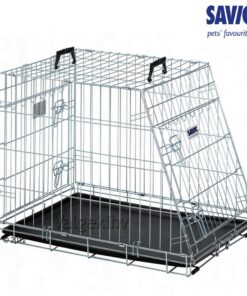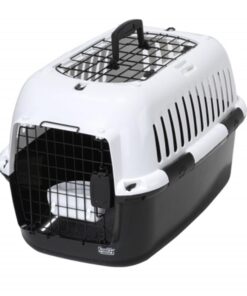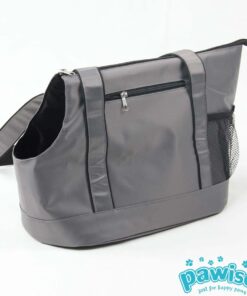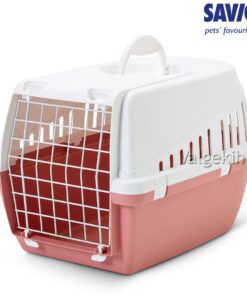Koerapuur Dog Residence, tsingitud 107 x 71 x 77 cm (Savic)
Dog Residence koerapuurid on tugeva ehitusega, kvaliteetsed, lihtsasti kokkupandavad, siseruumides kasutatavad ja teisaldatavad.
Valikus puurid erinevates suurustes.
Koerapuuri sobivad vaibad DELUXE ja TRAVEL DOG
Savic kvaliteetsed koerapuurid
- Kokkulapitavate külgedega puuri kokkupanek ja lahtivõtmine on lihtne ning kiire.
- Kõigil ustel on kaks kinnitust.
- Kõigil koerapuuridel (va 61 cm) on uksed nii ees kui ka küljel, mis võimaldab neid mugavalt kasutada ka autos.
- 61 cm puuril on uks ees ja peal.
- Tugevast plastikust põhi on soe ja kergesti puhastatav.
- Põhja saab puhastamiseks mugavalt külje pealt välja tõmmata.
Miks koerad armastavad oma puuri?
Erinevalt enamuse inimeste arvamusest meeldib koerale tegelikult oma puuris olla. Vabas looduses elavad koerlased kitsukestes urgudes. Puuris nagu uruski on vähe ruumi ning just seetõttu tundub puur koerale ohtude eest kaitstud paigana. Instinktiivselt valib koerlane vabas looduses uru – varjupaiga, mis pakub talle turvalisust ja rahu. Koera jaoks on puur alternatiiv urule.
- Kui koeral ei ole kodus oma kohta, sätib ta end tihti tooli või laua alla.
- Puur on koerale tema oma koht, kus ta saab ennast turvaliselt tunda. Koer teab, et puur on tema oma ja ta võib sinna alati varjule minna. Siiski ei tunne ta ennast puuris üksiku ega eraldatuna, kuna see on läbipaistev ja hästi ventileeritud.
- Koerte instinkt on hoida oma koht puhtana. Seepärast ootab ta puuris hädade tegemisega seni, kuni omanik ta välja jalutama viib.
- See võimaldab koerale õpetada väljaskäimise ajakava ning aitab vältida tuppa hädade tegemist.
- Koeral on vähem käitumisprobleeme nagu liigne haukumine või mööbli närimine.
- Kõige olulisem on, et puur on koerale turvaline koht ja ta on seeläbi rõõmsam ja enesekindlam.
- Koerte puurid on väga head abivahendid reisimisel ja koerte treenimisel toas elamiseks. Kuid puure saab kasutada ka käitumisprobleemide ennetamisel ja lahendamisel.
- Puur on turvaline ja ohutu koht, kus koer saab rahulikult magada.
Milleks on koerapuur kasulik?
- On abivahend kutsika treenimisel toas elamiseks.
- Võimaldab koertel ohutult reisida.
- Väldib kodus mööbli jm esemete närimist.
- Kaitseb koera kodus varitsevate ohtude eest, näiteks elektrijuhtmed ja mürgised puhastusvahendid.
- Pakub koerale kohta, kus haigusest või vigastusest taastudes puhata.
- On turvaline koht, kus koer saab magada. Puur on koerale tema enda varjupaik sinu kodus.
Ohutus
- Enne puuri kasutamist eemalda koeralt jalutusrihm, kaelarihm, rippuvad sildid.
- Ära kunagi jäta koera üksinda mänguasjadega, mis võivad teda vigastada.
- Äkkpidurduse või õnnetuse puhul on suur võimalus, et puur koos koeraga autos liigub. See on ohtlik koerale, juhile ja resijatele. Vigastuste vältimiseks soovitame puuri autos turvaliselt kinnitada. Koer tuleks kinnitada turvarakmete abil puuri külge. Kindlasti ei tohi koera puuri külge kinnitada jalutusrihma ja kaelarihma abil.
Kuidas õpetada koerale puuri kasutamist?
Samm 1. Tutuvusta koerale puuri kui tema uut kodu. Koera puuriga harjutamist tuleks alustada juba varakult, lase kutsikal puuris puhata ja magada. See õpetab talle, et tema uues „toas“ on mugav ja turvaline olla.
Julgusta koera ise enda puuri minema. Kui vaja, aseta puuri koeramaius. On normaalne, et alguses on ta pisut pelglik ja üritab eemalduda. Koera tuleb suhtuda mõistvalt ja teda ei tohi sundida. Ära ust sulge. Lase tal sisse või välja liikuda nii kuidas ta ise tahab.
Kui ta enam puuri ei karda, hoia kätt väljapääsu ees ja lase tal mõni hetk puuris olla. Suurenda puurisoleku aega järk-järgult. Ära unusta teda kiitmast!
Kui koer ka selle harjutusega ennast mugavalt tunneb (ilmselt pärast paaripäevaseid lühikesi treeningseansse), võib proovida puuri ust sulgeda. Nüüd on uks suletud ja jällegi ei tohi unustada koera kiitmast!
Varsti tunneb koer ennast oma uues kodus mugavalt ka siis, kui puuriuks on suletud. Tasapisi võib nüüd koerast ja puurist eemalduda, samas teda pidevalt hea käitumise eest kiites. Varsti istub koer puuris rahulikult ja on nõus oma uues kodus ka suletud uksega magama.
Samm 2. Õpeta oma koerale hädade tegemist. Kutsikal on vajadus oma hädasid teha iga 2-4 tunni järel. Kutsikas tuleks välja jalutama viia näiteks peale sööki, enne ja pärast magamist. Omanik peaks talle õpetama teed välisukseni, teda kiitma ning ta välja viima. See õpetab kutsikale selgeks väljas käimise rutiini, mis saab talle omaseks kogu eluks.
Kui kutsikas saab vanemaks (4–6 kuud), võib teda puuri kauemaks jätta. Veelgi vanema kutsika võib vajaduse korral juba ka pikemaks ajaks puuri jätta – seni, kuni omanik ta välja laseb.
Mõningad näpunäited
- Kutsikale koerapuuri ostes tuleks valida puur, mis oleks talle sobiv ka täiskasvanud koerana. Kutsikale on selline puur alguses liiga suur ning võib juhtuda, et ta teeb oma hädad ühte puuri nurka ning magab teises nurgas. Sellisel puhul on võimalik soetada puurile vastav eraldussein.
- Harjuta kutsikat oma uue puuriga.
- Puuri peaks asetama koerale mugava ja pehme pestava aseme. Puur tuleks seest teha koerale nii mugavaks kui vähegi võimalik. Soovitame puuris kasutatavat koera aset võimalikult tihti pesta, et see koera jaoks puhtana hoida.
- Kutsikal ja tema tegevustel tuleks kodus silma peal hoida. Jälgimise abil on võimalik tema käitumist suunata. Haukumine, hädade tegemine ja närimine on kõik sõltuvad peremehe õpetusest. Kui koerale käitumist ei õpetata, toimetab ta ise enda parima äranägemise järgi!
- Ära jäta koera terveks päevaks oma puuri. Kuuenädalane kutsikas suudab oma häda hoida umbes 4 tundi, 8-nädalane 5 tundi, 12-nädalane 6 tundi ning 5- või 6-kuune umbes 8 tundi.
- Ära pane puuri ajalehti või pissilappe. Proovi juurutada koera instinkti, et tema kodu ei ole häda tegemise koht.
- Ära lase kutsikal toas liiga kaua järelevalveta ringi liikuda. Kui ta peaks hakkama käituma rahutult ja kannatamatult (märk sellest, et kutsikal on vaja häda), vii ta õue jalutama.
- Ära sunni kutsikat vastu tema tahtmist puuri minema. Kutsikale tuleks eriti esimestel päevadel puuri ettevaatlikult tutvustada.
- Ära kunagi kasuta puuri koera karistamiseks! Koera puur peab olema tema turvaline koht ja ta ei tohi seda seostada karistusega, hirmuga või muu negatiivsega.
